stop start CITROEN DS5 2017 Owner's Guide
[x] Cancel search | Manufacturer: CITROEN, Model Year: 2017, Model line: DS5, Model: CITROEN DS5 2017Pages: 403, PDF Size: 15.62 MB
Page 227 of 403
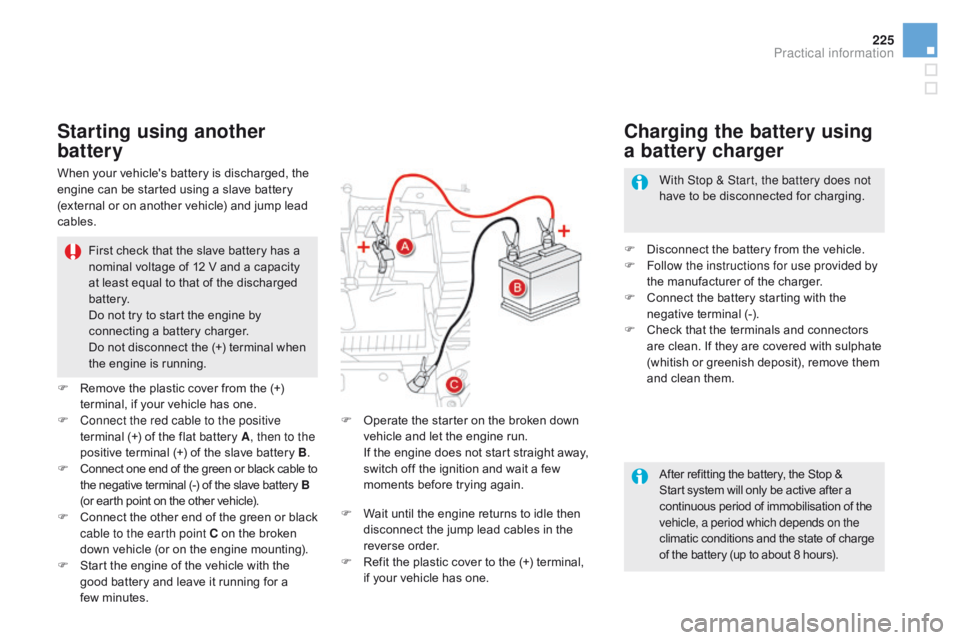
225
DS5_en_Chap08_info-pratiques_ed01-2015
After refitting the battery, the Stop &
Start system will only be active after a
continuous period of immobilisation of the
vehicle, a period which depends on the
climatic conditions and the state of charge
of the battery (up to about 8 hours). With Stop & Start, the battery does not
have to be disconnected for charging.
Starting using another
battery
First check that the slave battery has a
nominal voltage of 12 V and a capacity
at least equal to that of the discharged
battery.
Do not try to start the engine by
connecting a battery charger.
Do not disconnect the (+) terminal when
the engine is running.
F
R
emove the plastic cover from the (+)
terminal, if your vehicle has one.
F
C
onnect the red cable to the positive
terminal (+) of the flat battery A , then to the
positive terminal (+) of the slave battery B.
F
C
onnect one end of the green or black cable to
the negative terminal (-) of the slave battery B
(or earth point on the other vehicle).
F
C
onnect the other end of the green or black
cable to the earth point
c on the broken
down vehicle (or on the engine mounting).
F
S
tart the engine of the vehicle with the
good battery and leave it running for a
few
m
inutes. F
O
perate the starter on the broken down
vehicle and let the engine run.
I
f the engine does not start straight away,
switch off the ignition and wait a few
moments before trying again. F
D isconnect the battery from the vehicle.
F F ollow the instructions for use provided by
the manufacturer of the charger.
F
C
onnect the battery starting with the
negative terminal (-).
F
C
heck that the terminals and connectors
are clean. If they are covered with sulphate
(whitish or greenish deposit), remove them
and clean them.
charging the battery using
a battery charger
When your vehicle's battery is discharged, the
engine can be started using a slave battery
(external or on another vehicle) and jump lead
cables.
F
W
ait until the engine returns to idle then
disconnect the jump lead cables in the
reverse order.
F
R
efit the plastic cover to the (+) terminal,
if your vehicle has one.
Practical information
Page 229 of 403
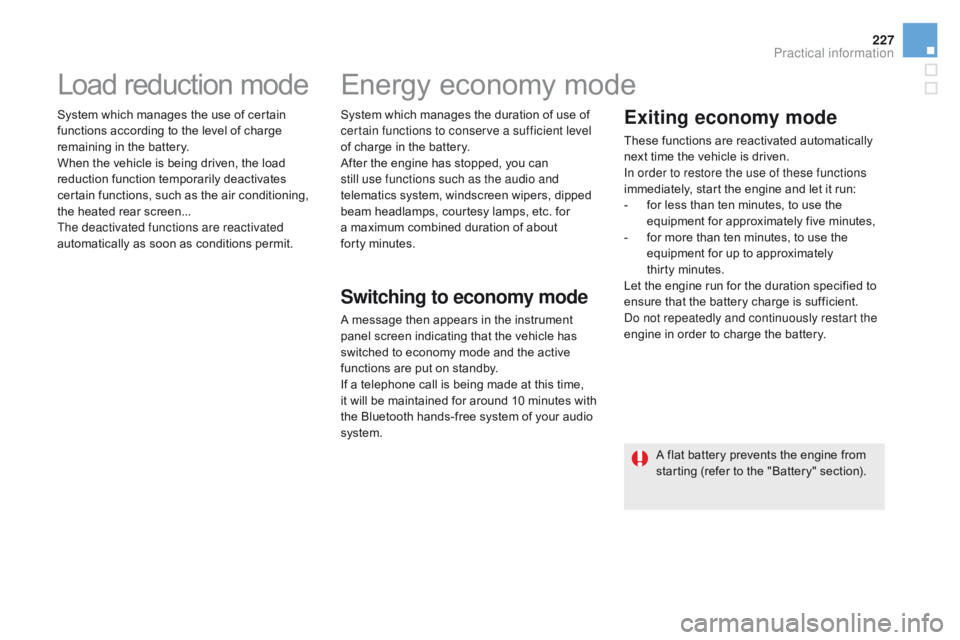
227
DS5_en_Chap08_info-pratiques_ed01-2015
Load reduction mode
System which manages the use of certain
functions according to the level of charge
remaining in the battery.
When the vehicle is being driven, the load
reduction function temporarily deactivates
certain functions, such as the air conditioning,
the heated rear screen...
The deactivated functions are reactivated
automatically as soon as conditions permit.System which manages the duration of use of
certain functions to conserve a sufficient level
of charge in the battery.
After the engine has stopped, you can
still use functions such as the audio and
telematics system,
windscreen wipers, dipped
beam headlamps,
courtesy lamps, etc. for
a maximum combined duration of about
forty
m
inutes.
Energy economy mode
Switching to economy mode
A message then appears in the instrument
panel screen indicating that the vehicle has
switched to economy mode and the active
functions are put on standby.
If a telephone call is being made at this time,
it will be maintained for around 10 minutes with
the Bluetooth hands-free system of your audio
system.
Exiting economy mode
These functions are reactivated automatically
next time the vehicle is driven.
In order to restore the use of these functions
immediately, start the engine and let it run:
-
f
or less than ten minutes, to use the
equipment for approximately five minutes,
-
f
or more than ten minutes, to use the
equipment for up to approximately
thirty
m
inutes.
Let the engine run for the duration specified to
ensure that the battery charge is sufficient.
Do not repeatedly and continuously restart the
engine in order to charge the battery.
A flat battery prevents the engine from
starting (refer to the "Battery" section).
Practical information
Page 243 of 403
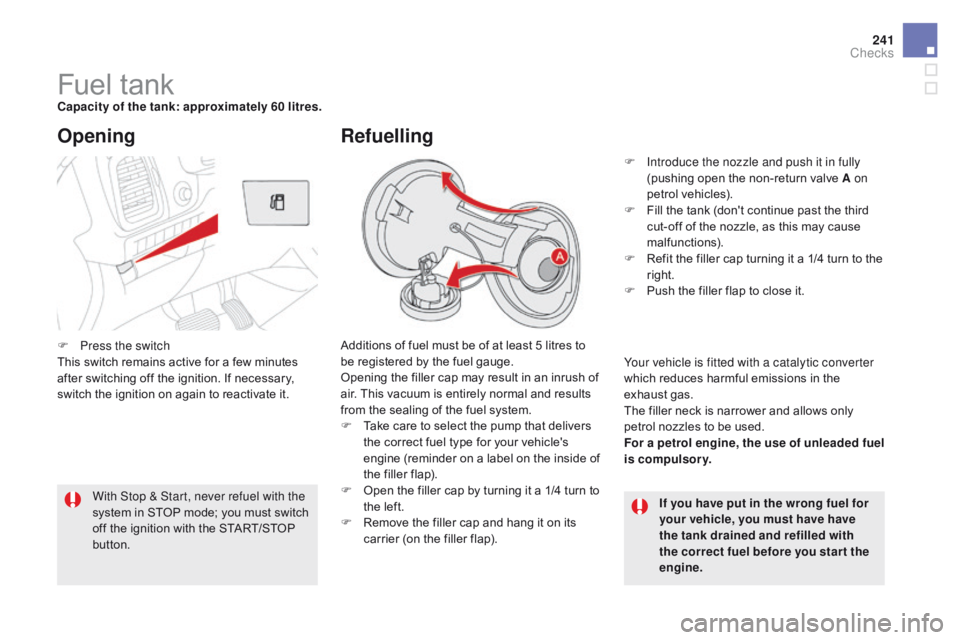
241
DS5_en_Chap09_verifications_ed01-2015
Fuel tankcapacity of the tank: approximately 60 litres.Additions of fuel must be of at least 5 litres to
be registered by the fuel gauge.
Opening the filler cap may result in an inrush of
air. This vacuum is entirely normal and results
from the sealing of the fuel system.
F
T
ake care to select the pump that delivers
the correct fuel type for your vehicle's
engine (reminder on a label on the inside of
the filler flap).
F
O
pen the filler cap by turning it a 1/4 turn to
the left.
F
R
emove the filler cap and hang it on its
carrier (on the filler flap).
Opening
If you have put in the wrong fuel for
your vehicle, you must have have
the tank drained and refilled with
the correct fuel before you star t the
engine.
With Stop & Start, never refuel with the
system in STOP mode; you must switch
off the ignition with the START/STOP
button.
Refuelling
F Introduce the nozzle and push it in fully
(pushing open the non-return valve A on
petrol vehicles).
F
F
ill the tank (don't continue past the third
cut-off of the nozzle, as this may cause
malfunctions).
F
R
efit the filler cap turning it a 1/4 turn to the
right.
F
P
ush the filler flap to close it.
Your vehicle is fitted with a catalytic converter
which reduces harmful emissions in the
exhaust gas.
The filler neck is narrower and allows only
petrol nozzles to be used.
For a petrol engine, the use of unleaded fuel
is compulsory.
F
P
ress the switch
This switch remains active for a few minutes
after switching off the ignition. If necessary,
switch the ignition on again to reactivate it.
checks
Page 246 of 403
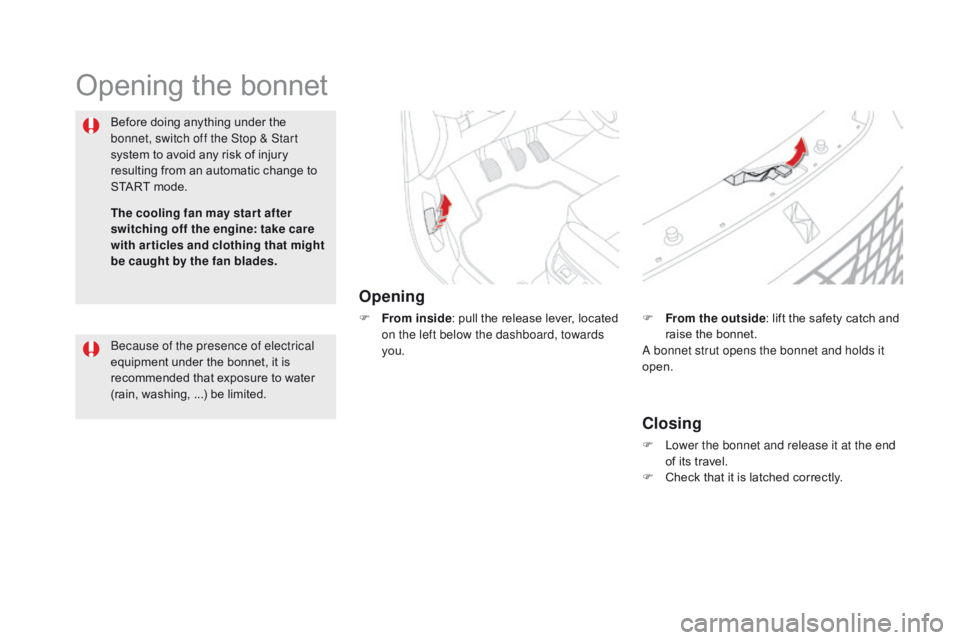
DS5_en_Chap09_verifications_ed01-2015
Opening the bonnet
Opening
F From inside: pull the release lever, located
on the left below the dashboard, towards
you.
Before doing anything under the
bonnet, switch off the Stop & Start
system to avoid any risk of injury
resulting from an automatic change to
START mode.
closing
F Lower the bonnet and release it at the end
of its travel.
F
C
heck that it is latched correctly.
F
F
rom the outside
: lift the safety catch and
raise the bonnet.
A bonnet strut opens the bonnet and holds it
open.
Because of the presence of electrical
equipment under the bonnet, it is
recommended that exposure to water
(rain, washing, ...) be limited. The cooling fan may star t after
switching off the engine: take care
with articles and clothing that might
be caught by the fan blades.
Page 254 of 403
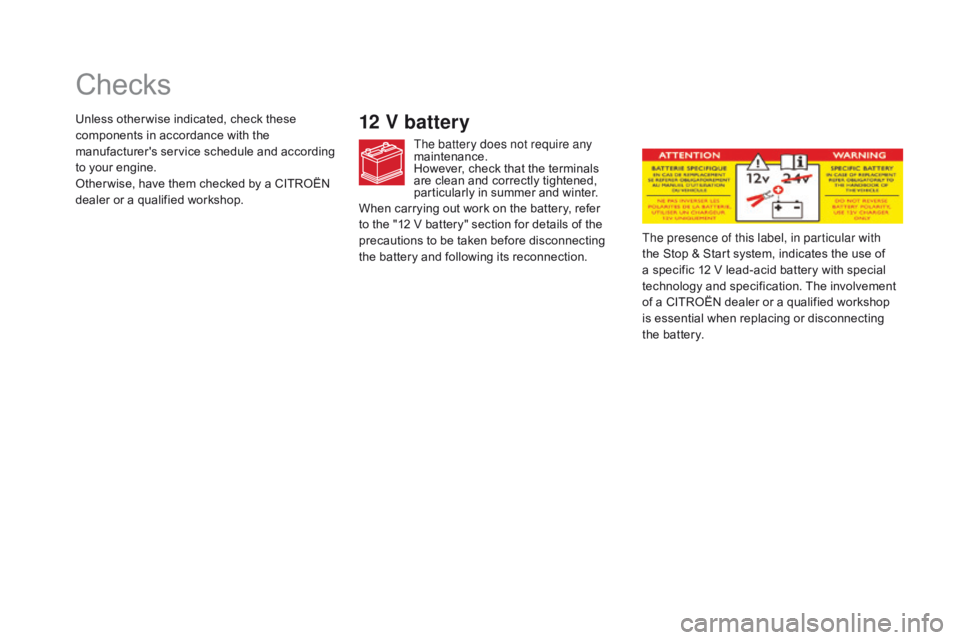
DS5_en_Chap09_verifications_ed01-2015
Checks
12 v battery
The battery does not require any
maintenance.
However, check that the terminals
are clean and correctly tightened,
particularly in summer and winter.The presence of this label, in particular with
the Stop & Start system, indicates the use of
a specific 12
V lead-acid battery with special
technology and specification. The involvement
of a CITROËN dealer or a qualified workshop
is essential when replacing or disconnecting
the battery.
Unless other wise indicated, check these
components in accordance with the
manufacturer's service schedule and according
to your engine.
Other wise, have them checked by a CITROËN
dealer or a qualified workshop.
When carrying out work on the battery, refer
to the "12
V battery" section for details of the
precautions to be taken before disconnecting
the battery and following its reconnection.
Page 263 of 403

261
DS5_en_Chap09_verifications_ed01-2015
Never store bottles of AdBlue® in your
vehicle. Before topping-up, ensure that the vehicle is
parked on a flat and level sur face.
In wintry conditions, ensure that the
temperature of the vehicle is above -11°C.
Other wise, by freezing, the AdBlue
® cannot
be poured into its tank. Park your vehicle in a
warmer area for a few hours to allow the top-up
to be carried out.
Procedure
F Press the START/STOP button to switch off the engine. F
R
aise the boot floor for access to the
AdBlue
® tank. Use an object, such as a
bag, to keep the left part up.
Recommendations on storage
AdBlue® freezes at about -11°C and
deteriorates above 25°C. It is recommended
that bottles be stored in a cool area and
protected from direct sunlight.
Under these conditions, the additive can be
kept for at least a year.
If the additive has frozen, it can be used once it
has completely thawed out.
checks
Page 265 of 403

263
DS5_en_Chap09_verifications_ed01-2015
F After emptying the bottle, wipe away any spillage around the tank filler using a damp
cloth.
F
R
efit the blue cap to the tank and turn it a
6
th of a turn clockwise, to its stop.
F
R
efit the black plastic blanking plug,
clipping it in place.
F
L
ower the boot floor and close the tailgate.
Important: if your vehicle's
AdBlue
® tank is completely empty -
w
hich is confirmed by the alert
messages and the impossibility of
starting the engine - you must add at
least 3.8 litres, so two 1.89 litre bottles. If any additive is split or splashed, wash
immediately with cold water or wipe
with a damp cloth.
If the additive has crystallised, clean it
off using a sponge and hot water.Important:
when topping up after
running out of additive , signalled
by the message "Top up emissions
additive: Starting prevented", you must
wait for approximately 5 minutes before
switching on the ignition, without
opening the driver's door, unlocking
the vehicle, placing the key of the
"Keyless Entr y and Star ting" system
inside the vehicle or inser ting the
electronic key in the reader.
Switch on the ignition, wait for
10
seconds, then start the engine.
Never dispose of AdBlue
® additive
bottles in the household waste. Place
them in a special container provided
this purpose or take them to your
dealer.
checks
Page 268 of 403
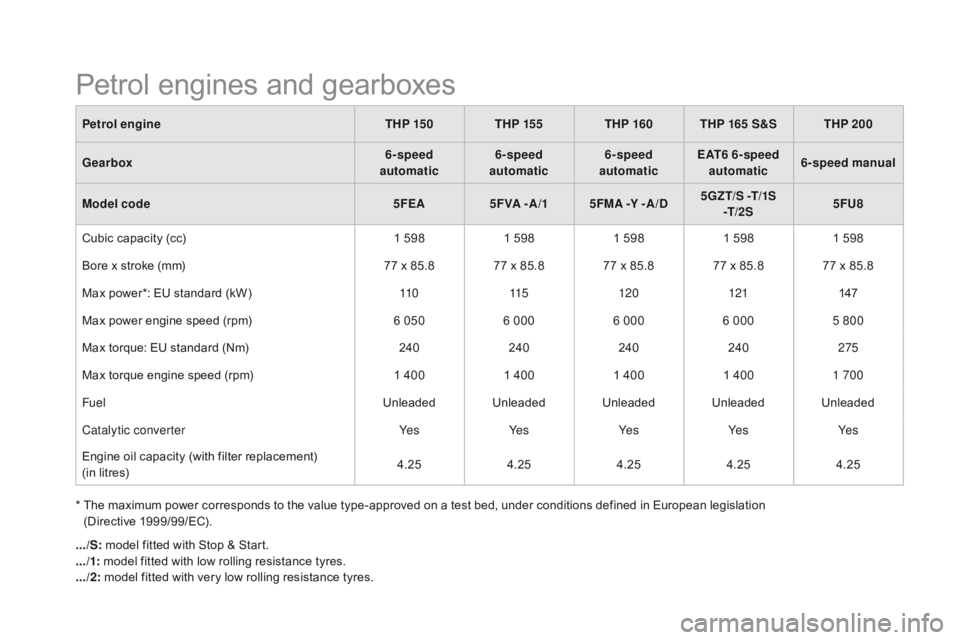
DS5_en_Chap10_caracteristiques_ed01-2015
Petrol engineTHP 15 0THP 155 THP 160 THP 165 S&S THP 200
Gearbox 6-speed
automatic 6-speed
automatic 6-speed
automatic EAT6 6-speed
automatic 6-speed manual
Model code 5FEA5 F
v
A - A /15FMA -Y -A /
d5
GZT/S -T/1S -T/2S 5FU8
Cubic capacity (cc) 1 5981 5981 5981 5981 598
Bore x stroke (mm) 77 x 85.8 77 x 85.8 77 x 85.8 77 x 85.8 77 x 85.8
Max power*: EU standard (kW) 11 0115120 121147
Max power engine speed (rpm) 6 0506 000 6 0006 000 5 800
Max torque: EU standard (Nm) 240240240240 275
Max torque engine speed (rpm) 1 4001 4001 4001 400 1 700
Fuel Unleaded Unleaded Unleaded Unleaded Unleaded
Catalytic converter Ye sYe sYe sYe sYe s
Engine oil capacity (with filter replacement)
(in litres) 4.25
4.254.254.254.25
Petrol engines and gearboxes
* The maximum power corresponds to the value type-approved on a test bed, under conditions defined in European legislation
(Directive 1999/99/EC).
.../S: model fitted with Stop & Start.
.../1: model fitted with low rolling resistance tyres.
.../2: model fitted with very low rolling resistance tyres.
Page 271 of 403
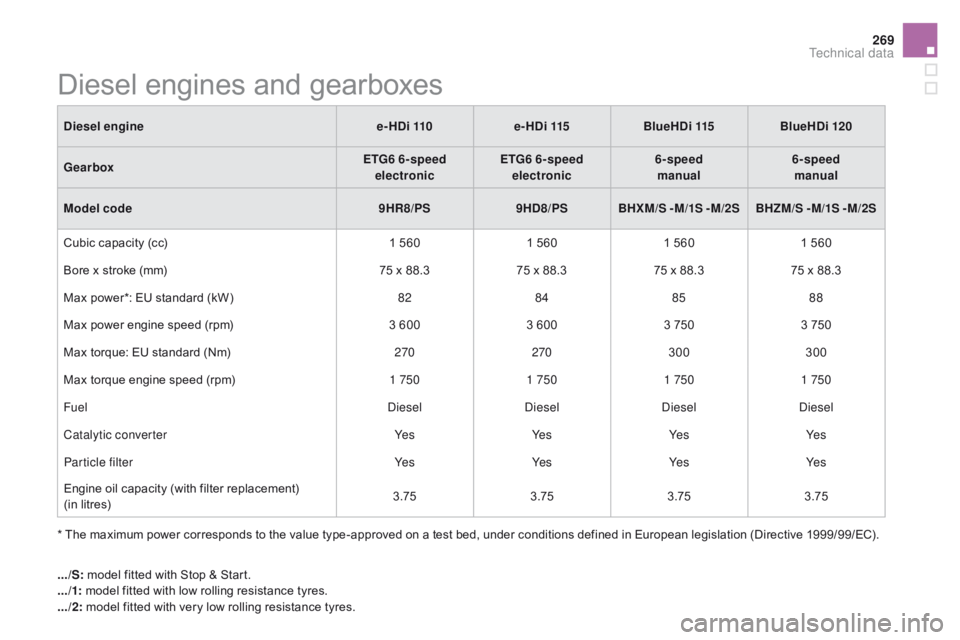
269
DS5_en_Chap10_caracteristiques_ed01-2015
Diesel engines and gearboxes
* The maximum power corresponds to the value type-approved on a test bed, under conditions defined in European legislation (Directive 1999/99/EC).
di
esel engine
e-H d i 110
e-H d i 115
BlueH d i 115
BlueH d i 120
Gearbox ETG6 6-speed
electronic ETG6 6-speed
electronic 6-speed
manual 6-speed
manual
Model code 9HR8/PS9H
d8
/PS
BHXM/S -M/1S -M/2S BHZM/S -M/1S -M/2S
Cubic capacity (cc) 1 5601 5601 5601 560
Bore x stroke (mm) 75 x 88.375 x 88.375 x 88.375 x 88.3
Max power*: EU standard (kW) 8284 8588
Max power engine speed (rpm) 3 6003 600 3 7503 750
Max torque: EU standard (Nm) 270270300 300
Max torque engine speed (rpm) 1 7501 7501 7501 750
Fuel DieselDieselDieselDiesel
Catalytic converter Ye sYe sYe sYe s
Particle filter Ye sYe sYe sYe s
Engine oil capacity (with filter replacement)
(in litres) 3.75
3.753.753.75
.../S: model fitted with Stop & Start.
.../1: model fitted with low rolling resistance tyres.
.../2: model fitted with very low rolling resistance tyres.
Technical data
Page 272 of 403
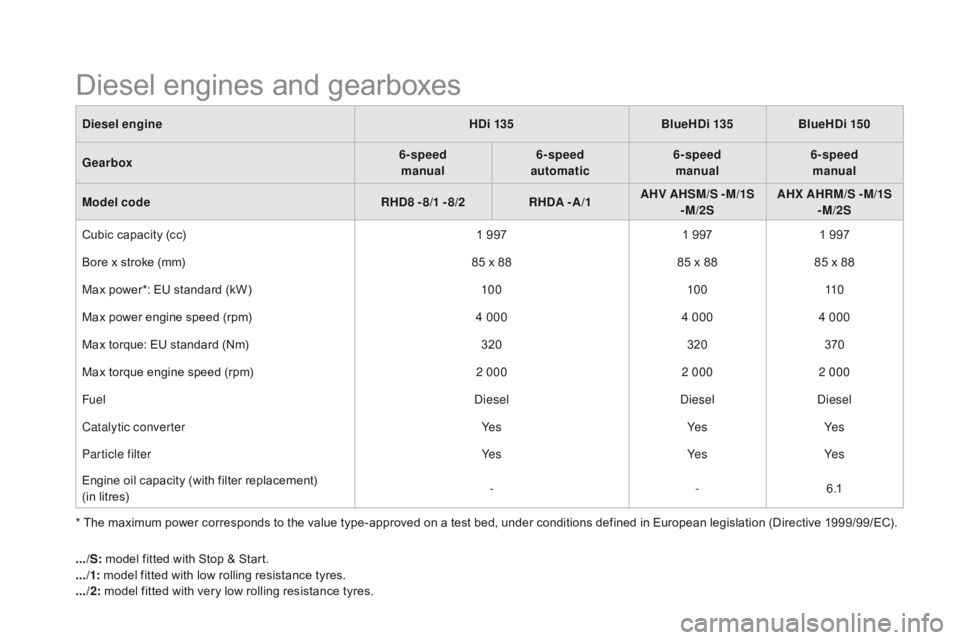
DS5_en_Chap10_caracteristiques_ed01-2015
* The maximum power corresponds to the value type-approved on a test bed, under conditions defined in European legislation (Directive 1999/99/EC).
di
esel engine
H d i 135
BlueH d i 135
BlueH d i
15 0
Gearbox 6-speed
manual 6-speed
automatic 6-speed
manual 6-speed
manual
Model code RH
d8 -
8/1 - 8/2
RH
d
A -A /1
AH
v
AHSM/S - M/1S
-M/2S AHX AHRM/S -M/1S
-M/2S
Cubic capacity (cc) 1 9971 9971 997
Bore x stroke (mm) 85 x 8885 x 8885 x 88
Max power*: EU standard (kW) 10 010 011 0
Max power engine speed (rpm) 4 0004 0004 000
Max torque: EU standard (Nm) 320320370
Max torque engine speed (rpm) 2 0002 0002 000
Fuel DieselDieselDiesel
Catalytic converter Ye sYe sYe s
Particle filter Ye sYe sYe s
Engine oil capacity (with filter replacement)
(in litres) -
-6 .1
Diesel engines and gearboxes
.../S: model fitted with Stop & Start.
.../1: model fitted with low rolling resistance tyres.
.../2: model fitted with very low rolling resistance tyres.